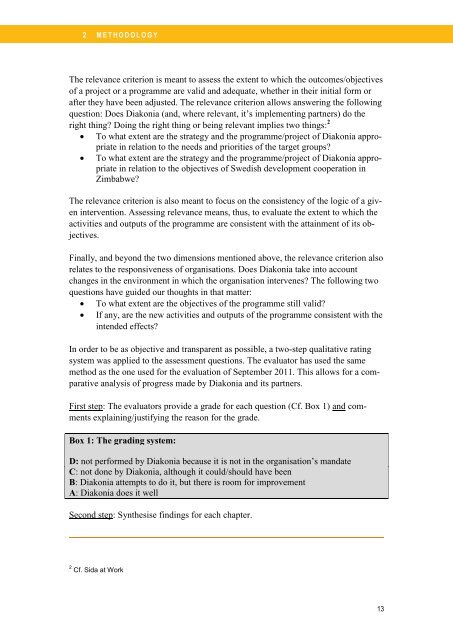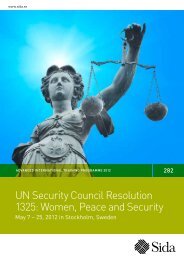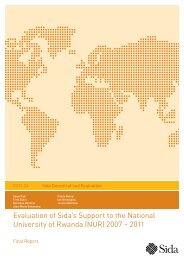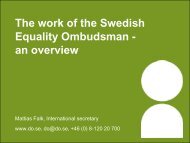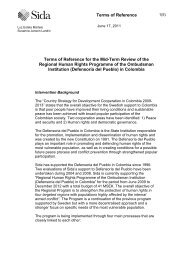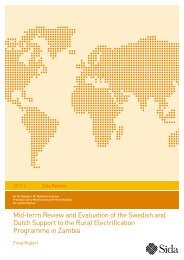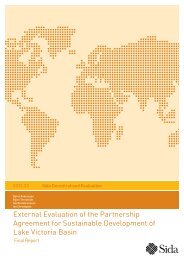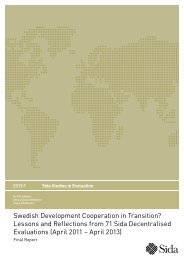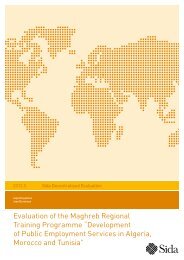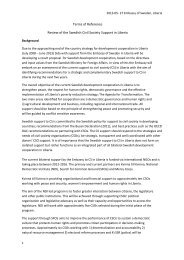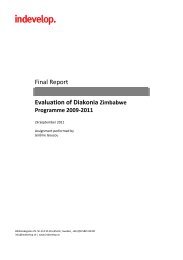Mid-term Review of the Diakonia Strategic Peace Building ... - Sida
Mid-term Review of the Diakonia Strategic Peace Building ... - Sida
Mid-term Review of the Diakonia Strategic Peace Building ... - Sida
You also want an ePaper? Increase the reach of your titles
YUMPU automatically turns print PDFs into web optimized ePapers that Google loves.
2<br />
2 M E T H O D O L O G Y<br />
The relevance criterion is meant to assess <strong>the</strong> extent to which <strong>the</strong> outcomes/objectives<br />
<strong>of</strong> a project or a programme are valid and adequate, whe<strong>the</strong>r in <strong>the</strong>ir initial form or<br />
after <strong>the</strong>y have been adjusted. The relevance criterion allows answering <strong>the</strong> following<br />
question: Does <strong>Diakonia</strong> (and, where relevant, it’s implementing partners) do <strong>the</strong><br />
right thing? Doing <strong>the</strong> right thing or being relevant implies two things: 2<br />
To what extent are <strong>the</strong> strategy and <strong>the</strong> programme/project <strong>of</strong> <strong>Diakonia</strong> appropriate<br />
in relation to <strong>the</strong> needs and priorities <strong>of</strong> <strong>the</strong> target groups?<br />
To what extent are <strong>the</strong> strategy and <strong>the</strong> programme/project <strong>of</strong> <strong>Diakonia</strong> appropriate<br />
in relation to <strong>the</strong> objectives <strong>of</strong> Swedish development cooperation in<br />
Zimbabwe?<br />
The relevance criterion is also meant to focus on <strong>the</strong> consistency <strong>of</strong> <strong>the</strong> logic <strong>of</strong> a given<br />
intervention. Assessing relevance means, thus, to evaluate <strong>the</strong> extent to which <strong>the</strong><br />
activities and outputs <strong>of</strong> <strong>the</strong> programme are consistent with <strong>the</strong> attainment <strong>of</strong> its objectives.<br />
Finally, and beyond <strong>the</strong> two dimensions mentioned above, <strong>the</strong> relevance criterion also<br />
relates to <strong>the</strong> responsiveness <strong>of</strong> organisations. Does <strong>Diakonia</strong> take into account<br />
changes in <strong>the</strong> environment in which <strong>the</strong> organisation intervenes? The following two<br />
questions have guided our thoughts in that matter:<br />
<br />
<br />
To what extent are <strong>the</strong> objectives <strong>of</strong> <strong>the</strong> programme still valid?<br />
If any, are <strong>the</strong> new activities and outputs <strong>of</strong> <strong>the</strong> programme consistent with <strong>the</strong><br />
intended effects?<br />
In order to be as objective and transparent as possible, a two-step qualitative rating<br />
system was applied to <strong>the</strong> assessment questions. The evaluator has used <strong>the</strong> same<br />
method as <strong>the</strong> one used for <strong>the</strong> evaluation <strong>of</strong> September 2011. This allows for a comparative<br />
analysis <strong>of</strong> progress made by <strong>Diakonia</strong> and its partners.<br />
First step: The evaluators provide a grade for each question (Cf. Box 1) and comments<br />
explaining/justifying <strong>the</strong> reason for <strong>the</strong> grade.<br />
Box 1: The grading system:<br />
D: not performed by <strong>Diakonia</strong> because it is not in <strong>the</strong> organisation’s mandate<br />
C: not done by <strong>Diakonia</strong>, although it could/should have been<br />
B: <strong>Diakonia</strong> attempts to do it, but <strong>the</strong>re is room for improvement<br />
A: <strong>Diakonia</strong> does it well<br />
Second step: Syn<strong>the</strong>sise findings for each chapter.<br />
2 Cf. <strong>Sida</strong> at Work<br />
13


